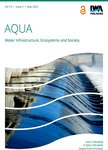版权所有:内蒙古大学图书馆 技术提供:维普资讯• 智图
内蒙古自治区呼和浩特市赛罕区大学西街235号 邮编: 010021

作者机构:Pusan Natl Univ Dept Mech Engn 2 Busandaehak Ro63 Beon Gil Busan South Korea Flowork Lab Res & Dev Dept 8 Seojeon Ro Busan South Korea
出 版 物:《AQUA-WATER INFRASTRUCTURE ECOSYSTEMS AND SOCIETY》 (Aqua Water Infrastruct. Ecosyst. Soc.)
年 卷 期:2024年第73卷第7期
页 面:1358-1371页
核心收录:
基 金:Korea Planning & Evaluation Institute of Industrial Technology - Ministry of the Interior and Safety
主 题:data acquisition machine learning algorithm network anomaly detection operational insight pressure wave detection water distribution network
摘 要:This study investigates rapid dynamic pressure variations in water distribution networks due to critical incidents such as pipe bursts and valve operations. We developed and implemented a machine learning (ML)-based methodology that surpasses traditional slow cycles of pressure data acquisition, facilitating the efficient capture of transient phenomena. Employing the Orion ML library, which features advanced algorithms including long short-term memory dynamic threshold, autoencoder with regression, and time-series anomaly detection using generative adversarial networks, we engineered a system that dynamically adjusts data acquisition frequencies to enhance the detection and analysis of anomalies indicative of system failures. The system s performance was extensively tested using a pilot-scale water distribution network across diverse operational conditions, yielding significant enhancements in detecting leaks, blockages, and other anomalies. The effectiveness of this approach was further confirmed in real-world settings, demonstrating its operational feasibility and potential for integration into existing water distribution infrastructures. By optimizing data acquisition based on learned data patterns and detected anomalies, our approach introduces a novel solution to the conventionally resource-intensive practice of high-frequency monitoring. This study underscores the critical role of advanced ML techniques in water network management and explores future possibilities for adaptive monitoring systems across various infrastructural applications. HIGHLIGHTS Developed a machine learning (ML)-based system to dynamically monitor pressure in water networks. Utilized advanced Orion ML library algorithms for real-time anomaly detection. Enhanced operational efficiency by optimizing data acquisition rates. Demonstrated effectiveness in pilot and real-world water distribution settings. Integrated Orion ML library with advanced algorithms to improve infrastructure resilience.